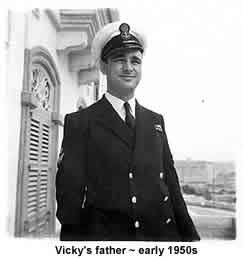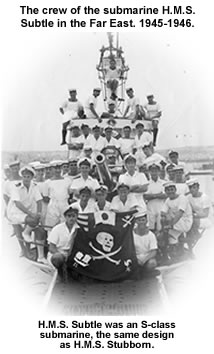My dad joined the Royal Navy in 1942, as soon as he was old enough, and trained as a telegraphist. During the latter part of the Second World War he served in submarines, firstly in the North Atlantic and then in the Pacific.
Fortunately he got through the war “shaken, not stirred”, as he put it. In the manner of old sea dogs, he was fond of telling us some of the high (and low) lights of his naval career.

His first three years were in the S-class submarines, some of which were used to tow the midget submarines across for the raids on the German battleship ‘Tirpitz’.
His abiding memory of these North Atlantic campaigns was the intense cold. In those days conditions were rather primitive.
On a typical four-week mission, the crew wore all the clothing they had: long johns in addition to standard navy-issue underwear, plus real flannel vests which, being rather rough, itched like mad. Over this went a navy sweater topped off by a heavy-knit white submariner’s jersey. They slept in their greatcoats.
It was almost impossible to have a proper wash all the time they were on board. Apart from the ambient temperate not being conducive to it, the only water available for washing was the distillate from the dehumidifiers, which was rather less than sanitary. When you came off ship and stripped to have a bath, your skin wasn’t dirty, but all the dead layers sloughed off at a touch so you looked like a big white caterpillar emerging from a pupa.
You can imagine the atmosphere on board, with a crew of over 30 men living closely together in cramped conditions for weeks at a time.
One of his most dramatic stories concerned ‘HMS Stubborn’. After the raid on the ‘Tirpitz’, the campaign continued on the German convoys in the North Atlantic. On 13th February 1944, after one such raid in a fjord near Trondheim, Norway, ‘Stubborn’ was shelled and depth-charged. Although she didn’t sustain a direct hit, she took something of a battering and the hydroplane mechanism jammed, sending the ship into an uncontrollable dive. By some magnificent effort she was pulled out of this dive and surfaced very rapidly, almost jumping out of the water like a dolphin.

However, this made her clearly visible to the enemy again, who commenced another attack. She dived again, but this time she ended up on the sea bed, off the scale of the depth gauge, and well below the depth the outer hull was designed to withstand.
With the ship submerged and unable to surface, the crew were facing the prospect of a relatively quick death by drowning if the hull gave way, or a much slower death by suffocation if it didn’t. It was a horrific experience, listening to the eerie creaks and groans, expecting some weakness in a weld or rivet to give way at any moment.
The captain, a young lieutenant on his first command, had the bright idea of trying to get the submarine to rise under its own momentum. He got the crew to run from one end of the boat to the other and throw themselves in a heap, in the manner of a rugby scrum. He hoped the change in the centre of gravity would rock the boat backwards and forwards and get her to rise. Although this did make her alter her position slightly, she didn’t move far off the sea bed.
Not one to give up easily, he then tried a very risky plan involving diverting the crew’s breathing air into the compressors. This had the desired effect: she rose so quickly that she was catapulted almost vertically out of the water. The crew were flung about by the speed of the ascent and several of them were injured.
Unable to risk diving again, she had to get away as fast as possible, all the time risking another trouncing by the Germans. Once further out to sea, two destroyers started towing her back to base, but the tow-rope came adrift in heavy seas. Her rudder and buoyancy tanks had been damaged, so she was very difficult to manoeuvre and floundered around awkwardly at the mercy of the gales. It was a very uncomfortable journey back home.
Eventually she picked up another tow from a Norwegian warship and finally made it into port, to be greeted by a hero’s welcome. The captain’s great achievement in saving both the ship and his men was later recognised by a DSO.
The story was well reported in the newspapers of the time, and I found some clippings and photos amongst my dad’s papers after he died. However, it was only after I read through his naval records detailing the ships he’d been on, that I found out he had not actually been on this mission. During February and March 1944 he had been on the depot ship ‘Forth’, which had formed part of the welcome committee when Stubborn finally arrived home.
The story of the Stubborn was published in the Times and several other newspapers on 13 March 1944.
Vicky the Viking
© Vicky the Viking 2008